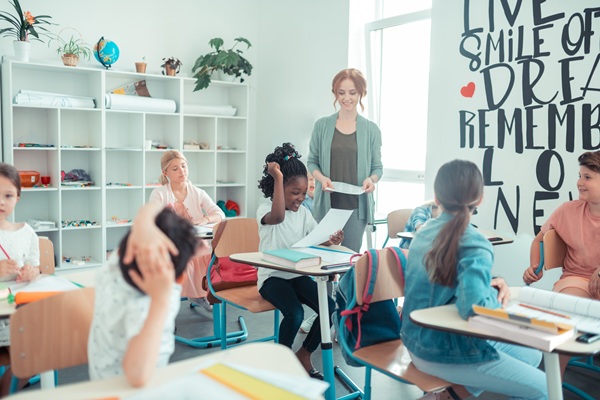Managing the classroom in a positive way

Effective classroom management involves establishing clear expectations, fostering relationships and creating a structured but welcoming atmosphere.
Teachers can use positive methods to guide their pupils through conflict by using active listening, promoting open communication, using inclusive teaching practices, teaching conflict resolution skills and encouraging collaboration between pupils.
Establishing clear expectations and consistent routines
Providing pupils with clear rules and expectations and consistent routines is important, as is remaining calm and actively listening to pupil issues. Consistency and structure are comforting to pupils and help them meet expectations, stay focused and feel secure.
Classroom routines can include:
- daily routines and clearly defined processes for the beginning and end of the school day;
- establishing schedules for different types of classroom work and subject areas;
- routines for other classroom procedures such as equipment use and transitioning as a group to activities outside the classroom;
- creating a list of expectations and routines, and/or a code of conduct, posted where it is visible to the class every day;
- defined sessions when pupils can provide their input.
Building strong teacher-pupil relationships
Teachers can resolve issues effectively by working together with pupils to resolve conflict: clearly identifying the conflict issues together and taking in their input about possible solutions, as well as providing advice.
Fostering a trusting, emotionally open environment where pupils feel comfortable approaching you with concerns can help teachers to defuse volatile pupil situations more quickly.
Active listening is a technique that demonstrates to pupils that their viewpoints have value and are respected. In the context of mediating pupil conflicts, active listening can establish trust between teacher and pupil and between pupils themselves. This helps create a safe learning environment where pupils feel comfortable openly sharing differing perspectives.
Using social-emotional learning
Social-emotional learning (SEL) is a valuable technique for creating classroom environments where conflict can be resolved easily. Pupils are taught to use active listening and other communications skills so that the interactions within the class are clear, positive and supportive, and they learn decision-making and problem-solving skills to help them deal with the conflicts, stresses and challenges.
Using SEL in classroom management enables teachers to establish expectations, rules and procedures for using these skills, and sets the tone for the ways pupils interact in the classroom environment.
Creating a safe, inclusive and respectful space
A classroom should be a space where every pupil feels valued, supported and empowered to succeed. When pupils feel that they belong, they are more likely to engage, participate and thrive in their learning journey.
- Make it clear that bullying, discrimination or disrespectful behaviour won’t be tolerated.
- Promote respect for diversity in all its forms – cultural, linguistic, disability and neurodiversity.
- Arrange the classroom to be welcoming and comfortable for pupils’ physical and emotional safety.
- Address conflicts or issues directly and constructively to ensure every pupil feels safe.
Promoting collaborative learning
Teachers can also use cooperative learning strategies such as group projects and peer mediation, tutoring and discussion groups. Working with peers fosters a sense of community and helps pupils learn from one another.
Assigning classroom roles and responsibilities allows pupils to contribute and feel invested in the way the classroom is run. Rotating roles ensures that everyone has a chance to take responsibility and feel valued.
- Participants are more likely to stay on task and pay closer attention to the task at hand when their roles in the collaboration are clear and distinct.
- Pupils are less likely to feel left out when they have a particular duty that they are responsible for completing.
- Group roles encourage individual accountability – group members are more likely to hold each other accountable for not completing work.
- Equitably assigned roles can help combat stereotypical and gendered ideas.
Additional information
-
Education type:School Education
-
Target audience:TeacherStudent TeacherHead Teacher / PrincipalSchool PsychologistTeacher Educator
-
Target audience ISCED:Primary education (ISCED 1)Lower secondary education (ISCED 2)

